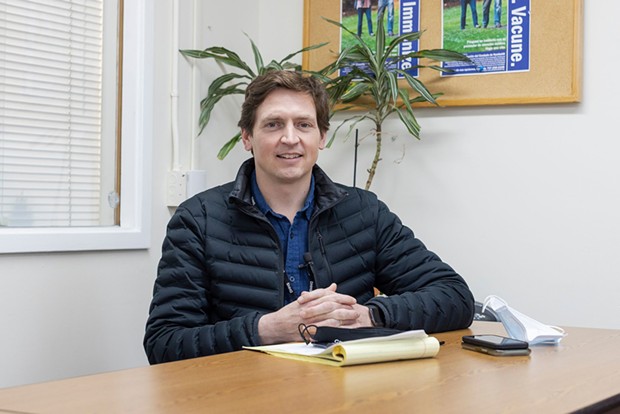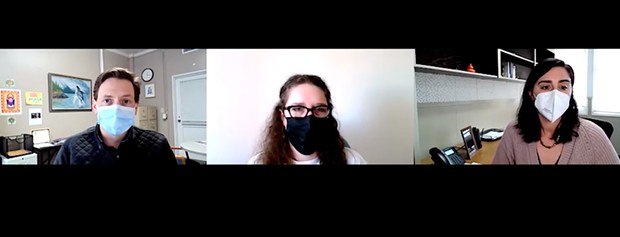Unmasked
Behind Humboldt's decision to follow the state's lead in hanging up the masks
By Thadeus Greenson [email protected] @ThadeusGreenson[
{
"name": "Top Stories Video Pair",
"insertPoint": "7",
"component": "17087298",
"parentWrapperClass": "fdn-ads-inline-content-block",
"requiredCountToDisplay": "1"
}
]
As the immediate past president of the Humboldt-Del Norte Medical Society, a family medicine doctor and chair of medicine at Redwood Memorial Hospital, Stephanie Dittmer understands the science of COVID-19 better than most. And she understands that the science says that wearing masks helps to prevent spread of the disease that has now killed more than 900,000 Americans, including 135 Humboldt County residents, while upending just about every aspect of life for two years.
"As far as protecting ourselves, wearing a mask is still the best way to do that. And for protecting others, wearing a mask is still the best way to do that," she says, adding part of her is concerned that Humboldt County will see an uptick in cases of the virus after Feb. 16, when local officials have agreed to follow the state's lead and drop a mask mandate for indoor public spaces, allowing fully vaccinated people to leave their masks at home, if they choose.
Nonetheless, Dittmer says she supports Health Officer Ian Hoffman's decision to roll back the mandate.
"Trying to walk that line of mandating people's behavior is a hard line to walk," she says. "We know what we have to do to protect ourselves. At some point, we have to let citizens make decisions, regardless of whether they're good. At some point, we all have to adult."
And in comments made explaining their decisions to let state and local masking orders lapse, health officials have made clear they believe that point is now. Speaking both to the Humboldt County Board of Supervisors and at a press conference last week, Hoffman said we're at a point of transition.
"As we move closer and closer to an endemic phase, we're going to see less restrictions and requirements and more recommendations," he said during the press conference.
What does the order do?
The new order that took effect Feb. 16 is, at least nominally, not a free for all. It still requires people not yet fully vaccinated for COVID-19 to mask in indoor public spaces, while lifting the requirement for those who are fully vaccinated, allowing them to "self-attest" to their vaccination status by dropping their masks.
Businesses and organizations will now be left to control their spaces as they see fit, Hoffman explained. Those that deem it appropriate can still require universal masking as a condition of entering the premises, or could check vaccination status as a condition for allowing people to go without masks.
What the order does not do is change health officials' recommendations .
"We do still recommend masking for everyone in all settings," Hoffman said. "The CDC continues to recommend masking for everyone in the 'substantial' and 'high' transmission areas, which we continue to be in with our case counts."
What does this mean for schools?
The order does not apply at this point to hospitals, healthcare settings, congregate living settings and schools, as a state order still requires universal masking in those settings, which have been deemed higher risk. During a Feb. 14 press conference, California Health and Human Services Secretary Mark Ghaly said the state will continue requiring universal masking in schools until at leastFeb. 28, saying the state wants to "pause and gather more information," keeping an eye on case numbers, test-positivity rates and hospitalizations.
Despite intense pressure from some sectors to ease the requirement in school settings, Ghaly, Hoffman and other health officials have pointed out that schools are unique — markedly different than a grocery store, restaurant or even a bar — in that they see kids sit in close proximity to each other for hours at a time, increasing the chances of transmission. Locally, many of Humboldt County's 30 school superintendents cited universal masking as a primary reason they have been able to keep kids in classrooms this year with minimal disruptions.
Ghaly underscored the importance of keeping schools open for in-person learning and said masks have been an important tool to that end, noting that California has only recorded 1 percent of the nation's COVID-19 related school closures despite having 12 percent of its school children, an indication that masking requirements have been effective. But Ghaly also stressed there will be an end to the statewide order.
"Masking requirements were never put in place to be there forever," he said. "It's not a question of if. It's a question of when."
If the state does rescind its universal school masking order, it would leave local school districts to navigate the politically charged question of whether to continue requiring masking on their campuses.
Why lift the mandate now?
Back in August, as the highly contagious Delta variant caused a surge in cases and hospitalizations locally, Hoffman reinstated Humboldt County's masking mandate, hoping it would help flatten the epidemiological curve and prevent hospitals from becoming overrun. In November, with the Delta surge having peaked, Hoffman then outlined three benchmarks the county would need to reach before the order would be lifted: The county would have to fall into the CDC's "moderate" transmission tier and stay there for three consecutive weeks, reach an 80 percent vaccination rate countywide and see a stabilization in hospital numbers.
Three months later, Humboldt County has not met any of those benchmarks. Case rates — while now far below a peak that saw 6,438 cases of the virus reported in January — remain "quite high," according to Hoffman, and still place the county in the CDC's "high" transmission tier. As of the county's last update, 64 percent of local residents are now fully vaccinated, up just 6 percent from when Hoffman laid out the benchmarks. The local hospital census, meanwhile, showed 25 people hospitalized with COVID-19 locally as of Feb. 14. While that's a far more manageable number than the local peak of 42 patients in September, it's also a more than tripling of the eight patients hospitalized at the time Hoffman set out the benchmarks.
Asked about this at last week's press conference, Hoffman said it's important to remember those benchmarks were laid out in November when Delta was the predominant variant, not Omicron, which has proven less likely to cause severe disease, hospitalization and death.
"Each one of these variants is almost like a new virus — they behave and act different," Hoffman said, adding that hospitals have fared "much better" through the Omicron surge, explaining that even hospitalized patients have shown "less acuity" than was the case with Delta.
Other conditions have also changed, Hoffman said, noting that vaccinations are now available to residents age 5 through 11, with 25 percent of that demographic fully vaccinated locally, while other populations have received booster shots to provide added protection against severe illness. Additionally, Hoffman said, a recent study looking at large numbers of cases from New York and California shows that natural immunity provides added layers of protection, with the risk of hospitalization stemming from re-infection "much lower" than the primary infections of people who have not been vaccinated.
"Knowing that gives another layer of understanding to that piece of community immunity," he said. "All these pieces have come together."
Treatments have also improved, Hoffman noted, explaining that antibody treatments have been largely effective at preventing severe illness, while promising oral antiviral medications have become available this year and rapid at-home tests are becoming more widely available.
"All these things are going into these decisions," he said.
What does this mean for the most vulnerable?
Like Dittmer, many health officials are concerned — or even expect — that easing public health mandates will invariably lead to an uptick in case counts and disease spread. And that's a more alarming prospect to some than others.
There's no question some are more at risk from the virus than others and while vaccination has been proven to reduce the risk of severe illness and death, it's not available to all. Humboldt County is home to roughly 8,000 children under the age of 5 who are not yet eligible for vaccines, while others have underlying health issues that prevent them from getting vaccinated or render the vaccines less effective. Still others — due to age or pre-existing health conditions — remain at elevated risk of severe illness even when vaccinated and boosted, while frontline workers continue to be at increased risk of exposure and infection.
Moving forward, health experts say, it will be increasingly important for these populations to make sure they're taking steps to protect themselves, from making sure they wear well-fitting, high quality — ideally N95 — masks when out in public to limiting exposures in private settings until case rates further recede, lessening the chances of exposure.
Tory Starr, executive officer at Open Door Community Health Centers, says the science is clear that masking works, helping to protect both the people wearing them and those around them, which people should keep in mind.
During his press conference, Ghaly pointed to a CDPH study that found wearing a cloth mask reduces the risk of COVID-19 transmission by 56 percent, while a KN95 or N95 quality mask reduces it by 83 percent.
"It never hurts to mask," Starr says. "The data is very clear that masking decreases transmission. There's no question about that. So, in general, any kind of public health intervention that helps prevent the spread of transmission of infectious disease is something we should take seriously."
For his part, Hoffman remained unequivocal in his stance that — despite the lack of an outright order — masking should remain universal: "Everyone is definitely encouraged to continue to wear a mask. Case counts are still high and our recommendation is to still mask in public spaces."
Dittmer agrees, adding that, especially in this time of transition, it's increasingly important that we simply be mindful of each other.
"I think we need to just remember that we're a community and we need to be kind to each other," she says. "People are tired. People's morale is exhausted. As we go forward, we need to just try to be kind to one another to re-create that culture that existed here before the pandemic that wasn't quite so divisive."
Thadeus Greenson (he/him) is the Journal's news editor. Reach him at 442-1400, extension 321, or [email protected]. Follow him on Twitter @thadeusgreenson.
Comments (4)
Showing 1-4 of 4
more from the author
-
Deputy Shoots Cutten Shooting Suspect
- Apr 25, 2024
-
Officials Weigh in on SCOTUS Case's Local Implications
- Apr 25, 2024
-
Arcata Lowers Earth Flag as Initiative Proponents Promise Appeal
- Apr 25, 2024
- More »
Latest in News
Readers also liked…
-
Through Mark Larson's Lens
A local photographer's favorite images of 2022 in Humboldt
- Jan 5, 2023
-
'To Celebrate Our Sovereignty'
Yurok Tribe to host gathering honoring 'ultimate river warrior' on the anniversary of the U.S. Supreme Court ruling that changed everything
- Jun 8, 2023

































